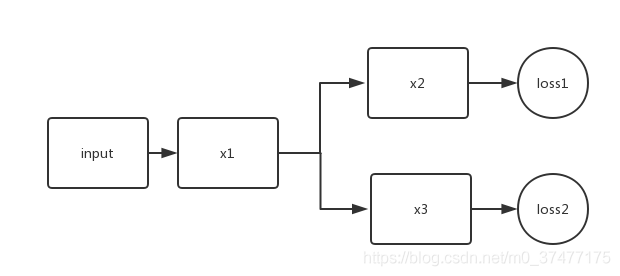关于keras多任务多loss回传的思考
发布日期:2022-04-12 12:46 | 文章来源:源码中国
如果有一个多任务多loss的网络,那么在训练时,loss是如何工作的呢?
比如下面:
model = Model(inputs = input, outputs = [y1, y2]) l1 = 0.5 l2 = 0.3 model.compile(loss = [loss1, loss2], loss_weights=[l1, l2], ...)
其实我们最终得到的loss为
final_loss = l1 * loss1 + l2 * loss2
我们最终的优化效果是最小化final_loss。
问题来了,在训练过程中,是否loss2只更新得到y2的网络通路,还是loss2会更新所有的网络层呢?
此问题的关键在梯度回传上,即反向传播算法。


所以loss1只对x1和x2有影响,而loss2只对x1和x3有影响。
补充:keras 多个LOSS总和定义

用字典形式,名字是模型中输出那一层的名字,这里的loss可以是自己定义的,也可是自带的
补充:keras实战-多类别分割loss实现
本文样例均为3d数据的onehot标签形式,即y_true(batch_size,x,y,z,class_num)
1、dice loss
def dice_coef_fun(smooth=1): def dice_coef(y_true, y_pred): #求得每个sample的每个类的dice intersection = K.sum(y_true * y_pred, axis=(1,2,3)) union = K.sum(y_true, axis=(1,2,3)) + K.sum(y_pred, axis=(1,2,3)) sample_dices=(2. * intersection + smooth) / (union + smooth) #一维数组 为各个类别的dice #求得每个类的dice dices=K.mean(sample_dices,axis=0) return K.mean(dices) #所有类别dice求平均的dice return dice_coef def dice_coef_loss_fun(smooth=0): def dice_coef_loss(y_true,y_pred): return 1-1-dice_coef_fun(smooth=smooth)(y_true=y_true,y_pred=y_pred) return dice_coef_loss
2、generalized dice loss
def generalized_dice_coef_fun(smooth=0): def generalized_dice(y_true, y_pred): # Compute weights: "the contribution of each label is corrected by the inverse of its volume" w = K.sum(y_true, axis=(0, 1, 2, 3)) w = 1 / (w ** 2 + 0.00001) # w为各个类别的权重,占比越大,权重越小 # Compute gen dice coef: numerator = y_true * y_pred numerator = w * K.sum(numerator, axis=(0, 1, 2, 3)) numerator = K.sum(numerator) denominator = y_true + y_pred denominator = w * K.sum(denominator, axis=(0, 1, 2, 3)) denominator = K.sum(denominator) gen_dice_coef = numerator / denominator return 2 * gen_dice_coef return generalized_dice def generalized_dice_loss_fun(smooth=0): def generalized_dice_loss(y_true,y_pred): return 1 - generalized_dice_coef_fun(smooth=smooth)(y_true=y_true,y_pred=y_pred) return generalized_dice_loss
3、tversky coefficient loss
# Ref: salehi17, "Twersky loss function for image segmentation using 3D FCDN" # -> the score is computed for each class separately and then summed # alpha=beta=0.5 : dice coefficient # alpha=beta=1: tanimoto coefficient (also known as jaccard) # alpha+beta=1: produces set of F*-scores # implemented by E. Moebel, 06/04/18 def tversky_coef_fun(alpha,beta): def tversky_coef(y_true, y_pred): p0 = y_pred # proba that voxels are class i p1 = 1 - y_pred # proba that voxels are not class i g0 = y_true g1 = 1 - y_true # 求得每个sample的每个类的dice num = K.sum(p0 * g0, axis=( 1, 2, 3)) den = num + alpha * K.sum(p0 * g1,axis= ( 1, 2, 3)) + beta * K.sum(p1 * g0, axis=( 1, 2, 3)) T = num / den #[batch_size,class_num] # 求得每个类的dice dices=K.mean(T,axis=0) #[class_num] return K.mean(dices) return tversky_coef def tversky_coef_loss_fun(alpha,beta): def tversky_coef_loss(y_true,y_pred): return 1-tversky_coef_fun(alpha=alpha,beta=beta)(y_true=y_true,y_pred=y_pred) return tversky_coef_loss
4、IoU loss
def IoU_fun(eps=1e-6): def IoU(y_true, y_pred): # if np.max(y_true) == 0.0: # return IoU(1-y_true, 1-y_pred) ## empty image; calc IoU of zeros intersection = K.sum(y_true * y_pred, axis=[1,2,3]) union = K.sum(y_true, axis=[1,2,3]) + K.sum(y_pred, axis=[1,2,3]) - intersection # ious=K.mean((intersection + eps) / (union + eps),axis=0) return K.mean(ious) return IoU def IoU_loss_fun(eps=1e-6): def IoU_loss(y_true,y_pred): return 1-IoU_fun(eps=eps)(y_true=y_true,y_pred=y_pred) return IoU_loss
以上为个人经验,希望能给大家一个参考,也希望大家多多支持本站。
版权声明:本站文章来源标注为YINGSOO的内容版权均为本站所有,欢迎引用、转载,请保持原文完整并注明来源及原文链接。禁止复制或仿造本网站,禁止在非www.yingsoo.com所属的服务器上建立镜像,否则将依法追究法律责任。本站部分内容来源于网友推荐、互联网收集整理而来,仅供学习参考,不代表本站立场,如有内容涉嫌侵权,请联系alex-e#qq.com处理。
相关文章
 关注官方微信
关注官方微信